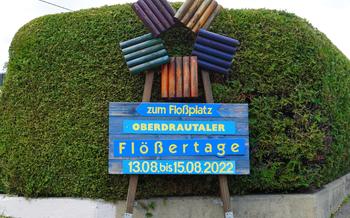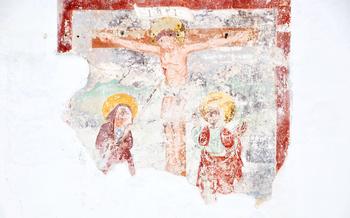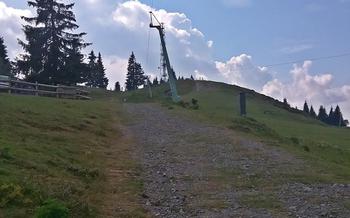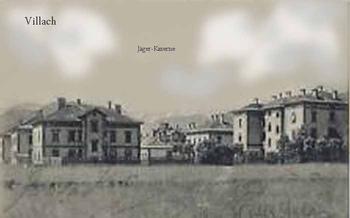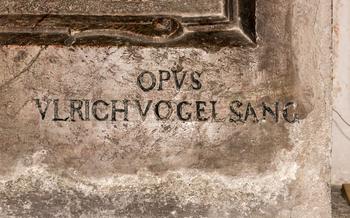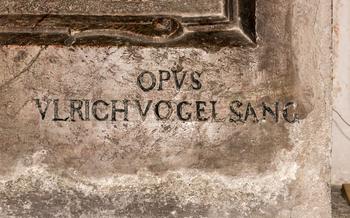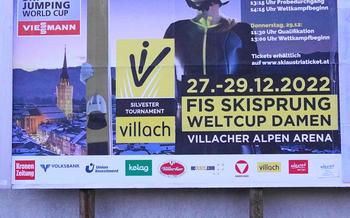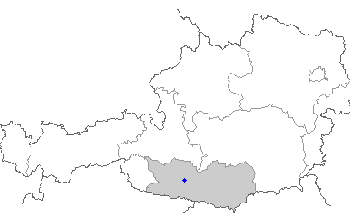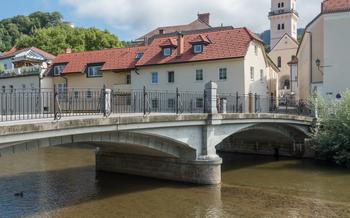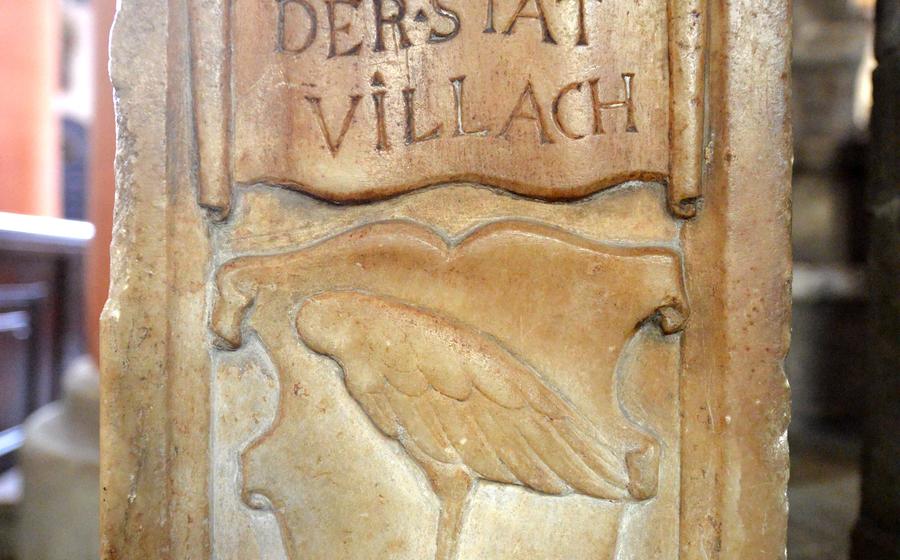
The Villach Pulpit
- The Villach Pulpit: A Masterpiece of Renaissance Art
- Exploring the Parish Church of St. Jakob
- Unveiling the Legend of the Pulpit's Creation
- Admiring the Pulpit's Exquisite Carvings
- Stepping Back in Time: The Pulpit's Historical Context
- Taking a Closer Look: Guided Tours of the Pulpit
- Capturing the Pulpit's Beauty: Photography Tips
- Discovering Villach's Artistic Heritage
- Strolling Through Villach's Old Town
- Exploring the Heart of Villach
- Uncovering Architectural Highlights
- Discovering Hidden Gems
- Shopping and Souvenirs
- Enjoying the Vibrant Atmosphere
- Indulging in Villach's Culinary Delights
- Exploring the Surrounding Region: Day Trips from Villach
- Getting Around Villach: Transportation Options
- Finding a Place to Stay: Accommodation in Villach
- Insider Tip: Unveiling the Hidden Gem
The Villach Pulpit: A Masterpiece of Renaissance Art
The Villach Pulpit stands as a testament to the creative genius of the Renaissance, captivating visitors with its intricate carvings and profound symbolism. Erected in 1566 within the Villach Parish Church, this magnificent pulpit is a masterpiece of Renaissance art, blending influences from Gothic and Renaissance styles. Its ornate design, featuring a hexagonal base adorned with elaborate carvings, sets it apart as a unique and awe-inspiring work of art.
The pulpit's intricate carvings depict scenes from the Bible, showcasing the profound influence of religion during the Renaissance. The artwork's meticulous attention to detail and rich symbolism invites viewers to embark on a journey through biblical narratives, immersing them in the stories and teachings that shaped the era.
Positioned prominently within the church, the pulpit serves as a powerful reminder of the importance of the spoken word in religious practice. Its placement allows the priest to deliver sermons and readings to the congregation, ensuring that the message of faith resonates throughout the sacred space.
Exploring the Parish Church of St. Jakob
The Parish Church of St. Jakob, nestled in the heart of Villach, is an architectural masterpiece that complements the grandeur of the Villach Pulpit. Its history dates back to the 12th century, when a Romanesque church stood on the same site. Over the centuries, the church underwent several expansions and renovations, resulting in a harmonious blend of architectural styles, including Gothic, Renaissance, and Baroque.
Inside the church, visitors are greeted by a sense of awe and tranquility. The nave is adorned with intricate frescoes depicting biblical scenes and the life of St. Jakob, the church's patron saint. The high altar, a masterpiece of Baroque art, is a testament to the church's artistic heritage. Stained glass windows bathe the interior with colorful light, creating a mystical atmosphere.
Beyond the pulpit, the Parish Church of St. Jakob is home to several other notable features and artwork. The 15th-century baptismal font, carved from a single block of marble, is a testament to the church's rich history. The Stations of the Cross, depicted in a series of expressive paintings, invite visitors to contemplate the Passion of Christ.
The church also plays a vital role in the community, serving as a spiritual and cultural center for the people of Villach. Regular masses, concerts, and events bring the community together, fostering a sense of belonging and shared identity. Guided tours of the church are available, providing visitors with insights into its history, architecture, and significance.
Unveiling the Legend of the Pulpit's Creation
The Villach Pulpit is steeped in a captivating legend that adds to its mystique and allure. The tale begins with Master Pilgrim, a renowned sculptor, who embarked on a journey to Villach, drawn by the allure of the city's vibrant artistic community. During his travels, he encountered a series of vivid dreams that inspired the design and creation of the pulpit.
In these dreams, Master Pilgrim received divine guidance, envisioning the intricate carvings and allegorical scenes that would adorn the pulpit. The dreams also revealed the pulpit's placement within the church, which was strategically positioned to ensure that the congregation would be captivated by its beauty and symbolism.
The legend further adds that the pulpit's orientation was not merely a matter of chance. Master Pilgrim believed that by aligning the pulpit towards the east, the rising sun would illuminate and enhance the intricate carvings, revealing their hidden meanings and symbolism.
Over time, the legend of Master Pilgrim and his divine inspiration became deeply embedded in the local folklore of Villach. The pulpit's creation is celebrated as a testament to the power of dreams, divine intervention, and the transformative nature of artistic expression.
Admiring the Pulpit's Exquisite Carvings
The pulpit's intricate carvings are a testament to the skill and artistry of its creator, Master Pilgrim. Each carving is meticulously crafted, depicting intricate biblical scenes and figures with remarkable detail. The pulpit's panels feature a harmonious blend of Old Testament and New Testament narratives, showcasing key moments from the Bible. The carvings vividly portray scenes from the Creation to the Crucifixion, capturing the essence of each story with exceptional precision and expressiveness.
The variety of materials used in the carvings adds to their depth and realism. Wood, stone, and metal harmoniously coexist, creating a rich and textured visual experience. The skillful use of color and gilding further enhances the carvings, bringing them to life and highlighting their symbolic significance.
Over the centuries, the pulpit's carvings have undergone meticulous restoration and preservation efforts to maintain their original beauty and integrity. These efforts have ensured that future generations can continue to appreciate the exquisite craftsmanship and artistry that went into creating this masterpiece.
Stepping Back in Time: The Pulpit's Historical Context
The Villach Pulpit stands as a testament to the rich history and cultural heritage of Villach and the surrounding region. The 16th century was a time of significant religious and political upheaval, shaped by the Protestant Reformation and the Catholic Church's response to it. The pulpit's creation during this period reflects the complex interplay between religion, politics, and art.
The Catholic Church, during the Renaissance, wielded considerable power and influence in society. It played a pivotal role in patronizing and commissioning works of art, often with the intent of reinforcing its authority and promoting its doctrines. The Villach Pulpit, with its intricate carvings depicting biblical scenes and figures, served as a powerful tool for disseminating religious teachings and reinforcing the Church's authority.
The Reformation, with its emphasis on individual interpretation of the Bible and its critique of the Church's practices, posed a significant challenge to the Catholic Church's dominance. The creation of the pulpit can be seen as a response to this challenge, an attempt to reassert the Church's authority and reaffirm its central role in the spiritual lives of the faithful.
The pulpit's placement within the Villach Parish Church, a prominent and central location, speaks to its importance and significance. It stands as a symbol of the Church's enduring presence and its commitment to preserving traditional religious practices in the face of religious and social change.
Taking a Closer Look: Guided Tours of the Pulpit
To fully appreciate the intricacies and symbolism of the Villach Pulpit, consider joining a guided tour. These tours offer an immersive experience, allowing visitors to step inside the pulpit and examine its unique features from up close. Knowledgeable guides provide insights into the history, symbolism, and craftsmanship of the artwork, bringing the pulpit's story to life.
Guided tours are typically offered on a regular basis, and reservations are recommended to secure a spot. During the tour, visitors will have the opportunity to admire the pulpit's intricate carvings, biblical scenes, and the use of different materials and techniques. Guides will explain the significance of the pulpit's placement and orientation within the church, shedding light on its religious and cultural context.
Participating in a guided tour of the Villach Pulpit is an excellent way to gain a deeper understanding of this masterpiece. It's an opportunity to learn about the artist's inspiration, the symbolism behind the carvings, and the role the pulpit played in the religious and cultural life of Villach.
Capturing the Pulpit's Beauty: Photography Tips
The Villach Pulpit is a true masterpiece of art, and capturing its beauty through photography is an experience in itself. To ensure the best possible results, consider the following tips:
-
Lighting: Natural light is always the best choice for photography. Aim to visit the church during the morning or late afternoon hours, when the light is softer and more diffused. Avoid harsh midday light, which can create unwanted shadows and contrasts.
-
Camera Settings: Use a tripod to stabilize your camera and prevent blur. Set your camera to a low ISO to minimize noise and maximize image quality. Aperture and shutter speed will depend on the lighting conditions, but generally, a narrow aperture (high f-stop number) will give you a sharp depth of field, ensuring that both the pulpit and its surroundings are in focus.
-
Angles and Perspectives: Experiment with different angles and perspectives to showcase the pulpit's grandeur. Try shooting from a low angle to emphasize its height and intricate details. Alternatively, climb up to the choir loft for a bird's-eye view that captures the pulpit's relationship to the rest of the church.
-
Etiquette and Guidelines: Remember that you are in a sacred space, so be respectful of other visitors and worshippers. Silence your camera's shutter sound and avoid using flash, which can be disruptive. Always ask permission before photographing anyone who may be present in the church.
Discovering Villach's Artistic Heritage
Beyond the Villach Pulpit, the city is home to a wealth of other artistic treasures. The Museum of Modern Art showcases a diverse collection of works from regional and international artists, spanning various periods and styles. The Villach City Museum delves into the city's rich history and culture, with exhibits on local traditions, industries, and prominent figures.
Art enthusiasts can also explore the Galerie im Alten Rathaus, housed in the historic Town Hall, which features rotating exhibitions of contemporary art. The Kunstraum Villach is another vibrant venue for showcasing local and international artists, often hosting workshops and events.
Strolling through Villach's streets, visitors can admire the many beautiful facades of buildings adorned with intricate carvings, frescoes, and sculptures. The Dreifaltigkeitssäule (Trinity Column) in the city center is a stunning example of Baroque architecture, while the Villacher Stadtpfarrkirche (Villach Parish Church) boasts a Gothic Revival exterior and a magnificent interior adorned with frescoes and stained glass windows.
Villach's artistic heritage is not limited to its museums and galleries. The city hosts numerous cultural events and festivals throughout the year, celebrating its rich traditions and vibrant arts scene. The Villacher Kirchtag is an annual festival that showcases traditional music, dance, and costumes, while the Villacher Fasching (Carnival) brings the city to life with colorful parades, parties, and performances.
Strolling Through Villach's Old Town
Villach's Old Town is a captivating labyrinth of cobblestone streets and squares, lined with colorful buildings, charming cafes, and unique shops. Take a leisurely stroll through this historic district to discover its hidden gems and architectural treasures.
Exploring the Heart of Villach
Begin your journey in Hauptplatz, the main square of Villach. Admire the intricate details of the town hall, with its Renaissance-style facade and clock tower. From here, wander along the pedestrianized streets, where you'll find a delightful mix of boutiques, art galleries, and traditional restaurants.
Uncovering Architectural Highlights
As you explore, keep an eye out for the many architectural highlights that dot the Old Town. Admire the Gothic spires of St. Nikolaus Church, the colorful facades of the 16th-century townhouses, and the elegant Baroque mansions that line the streets. Don't miss the Old City Hall, with its beautifully preserved Renaissance frescoes and the Fish Market Fountain, a symbol of Villach's rich history.
Discovering Hidden Gems
Venture off the beaten path to discover the Old Town's hidden gems. Seek out the secluded courtyards, where you'll find tranquil gardens and charming cafes. Explore the narrow alleyways, where you might stumble upon a hidden art gallery or a local artisan's workshop.
Shopping and Souvenirs
The Old Town is a shopper's paradise, offering a variety of local crafts, souvenirs, and unique gifts. Browse the boutiques for handmade jewelry, traditional Carinthian clothing, and exquisite ceramics. Be sure to visit the Old Town Market, where you can find fresh produce, local delicacies, and artisanal products.
Enjoying the Vibrant Atmosphere
As the sun sets, the Old Town transforms into a vibrant and lively destination. The streets come alive with locals and visitors alike, enjoying the outdoor cafes, restaurants, and bars. Savor the delicious Carinthian cuisine, listen to live music, and soak up the infectious atmosphere of this charming town.
Indulging in Villach's Culinary Delights
Villach's cuisine, a harmonious blend of Carinthian, Austrian, and Italian influences, is an integral part of the city's cultural heritage. Savor the region's culinary delights, starting with the iconic Kärntner Kasnudln, delectable ravioli-like dumplings filled with potatoes, cottage cheese, and herbs. Indulge in Reindling, a traditional braided pastry filled with nuts, cinnamon, and raisins, a beloved treat during festive occasions.
Villach's Old Town is a treasure trove of culinary experiences. Discover traditional restaurants tucked away in charming alleys, where you can relish hearty Schnitzel with lingonberry jam or savor the delicate flavors of Forellenfilet, a pan-fried trout fillet. For a taste of local specialties, visit the Bauernmarkt, a vibrant farmers' market showcasing fresh produce, artisanal cheeses, and homemade delicacies.
Don't miss the Villacher Kirchtag, an annual festival celebrating the city's patron saint. This lively event features food stalls serving traditional Carinthian dishes, accompanied by live music and dancing, creating a vibrant atmosphere that encapsulates Villach's culinary spirit.
Whether you prefer fine dining in elegant restaurants or casual meals in cozy cafes, Villach's culinary scene offers something for every palate. Embrace the opportunity to savor the flavors of this vibrant city, where food is not just sustenance but a cherished cultural expression.
Exploring the Surrounding Region: Day Trips from Villach
Nestled amidst the stunning landscapes of Carinthia, Villach serves as an ideal base for exploring the region's many hidden gems. A short drive from the city center, Lake Faaker See beckons with its crystal-clear waters, inviting visitors to bask in its picturesque beauty. Surrounded by lush forests and rolling hills, the lake offers a tranquil retreat where one can indulge in swimming, boating, or simply soak in the breathtaking views.
Ascending to new heights, the Dobratsch Mountain offers a panoramic spectacle that leaves visitors in awe. Accessible by car or cable car, the mountain's summit unveils a breathtaking vista of the surrounding Alps and valleys. Whether hiking through its scenic trails, marveling at the alpine flora, or simply taking in the invigorating mountain air, the Dobratsch Mountain promises an unforgettable experience.
Venturing further afield, the World Heritage Site of Hallstatt, a mere hour's drive from Villach, transports visitors back in time. This ancient salt-mining town, nestled amidst the majestic Dachstein Mountains, boasts a rich history dating back to prehistoric times. Explore its charming streets, marvel at its architectural wonders, and delve into the depths of its ancient salt mines, a testament to the town's enduring heritage.
Getting Around Villach: Transportation Options
Villach offers a variety of convenient transportation options to explore the city and its surroundings. The public transportation system is reliable and efficient, with buses and trams connecting different parts of the city. Visitors can purchase a "Villach Card," which provides unlimited access to public transportation, as well as discounts on attractions and cultural events.
For those who prefer to explore at their own pace, renting a car or bicycle is a great option. Several car rental agencies are located in Villach, and bike rental shops can be found throughout the city. Cycling is a popular way to get around, as Villach has a network of dedicated bike lanes and paths.
Walking is another great way to experience Villach's charm. The city center is compact and easily walkable, with many attractions and landmarks within a short distance of each other. Discover hidden corners and picturesque alleys that cars and buses can't reach.
No matter which mode of transportation you choose, getting around Villach is a breeze. The city's infrastructure is designed to make it easy for visitors to navigate and explore.
Finding a Place to Stay: Accommodation in Villach
Villach offers a diverse range of accommodation options to cater to the needs and preferences of travelers. Whether you seek the comfort of a luxurious hotel, the charm of a cozy guesthouse, or the independence of a vacation rental, Villach has it all.
For a truly immersive experience, consider staying in the heart of the Old Town. Here, you'll find charming hotels and guesthouses housed in historic buildings, offering easy access to the city's main attractions. For those seeking modern amenities and convenience, there are several reputable hotels located near the train station or on the outskirts of the city.
If you prefer a more personalized stay, opt for one of the many guesthouses or bed and breakfasts scattered throughout Villach. These cozy establishments often provide a warm and welcoming atmosphere, with the opportunity to interact with local hosts and fellow travelers.
For families or groups seeking more space and privacy, vacation rentals are an excellent choice. These fully equipped apartments or houses offer the flexibility and convenience of having your own kitchen and living area.
To ensure a hassle-free stay, it's advisable to book your accommodation in advance, especially during the peak tourist season (July-August) and major events like the Villach Christmas Market. Online booking platforms and local tourist information centers can assist you in finding the perfect place to stay within your budget.
Whether you choose a grand hotel, a quaint guesthouse, or a cozy vacation rental, you're sure to find the ideal accommodation to complement your unique travel style and make your stay in Villach truly memorable.
Insider Tip: Unveiling the Hidden Gem
Beyond the pulpit's mesmerizing exterior lies a hidden gem waiting to be discovered. A discreet passageway, concealed within the intricate carvings, leads to a secret chamber within the pulpit's interior. This hidden sanctuary offers a unique perspective and an intimate encounter with the artwork's intricate details.
Accessing the secret chamber is akin to embarking on a journey through time. Visitors can carefully navigate the narrow passageway, guided by the soft glow of ambient light. Once inside, they are greeted by a breathtaking panorama of biblical scenes and figures, rendered with astonishing precision and artistry.
From this vantage point, visitors can marvel at the pulpit's intricate carvings from a new perspective, appreciating the skill and dedication of the master craftsmen who created this masterpiece. The hidden chamber provides a deeper understanding of the pulpit's symbolism and biblical references, inviting visitors to contemplate the stories and messages embedded within the artwork.
To discover this hidden treasure, visitors should inquire at the Villach Parish Church office or join a guided tour that includes access to the secret passageway. This exclusive experience offers a truly unforgettable encounter with the Villach Pulpit, leaving visitors with a lasting impression of its beauty, craftsmanship, and profound historical significance.
